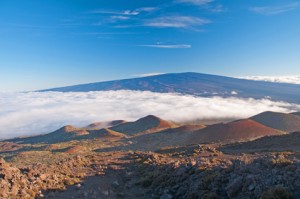
Shield Volcano Mauna Loa
The interesting fact about shield volcanoes are formed when there are effusive volcanic eruptions with magma flowing out in all directions to form a shield-like form. They are built of weak viscous basaltic lava. The effusive eruptions allow lava to flow long distances than other types of volcanic eruptions making larger and thinner sheets of lava. The continuous build of the sheets over a long period of time construct a low broad profile of shield volcano. The types of eruptions at shield volcanoes are known as Hawaiian after the Hawaiian chain where they prominently occur.
Magma chamber that is located at the base of the volcano and is the reservoir of the magma that flows out during eruptions.
Magma conduit is the main pipe that delivers the magma from the magma chamber during eruptions.
Dike is a secondary pipe forming on the side of the shield volcano through which magma flows from the magma conduit.
Sill is a tubular intrusion in the lava sheets fed by dikes and lie parallel to the lava sheets. They form when magma intrude the parent rock sheets.
Stratum is a layer of lava that is formed as magma flows and is solidified on the surface. The continuous layers form the shield volcano.
Fumaroles are an opening on the volcano that emits gases and steam from the superheated water inside the volcano.
Crater is a circular depression on top of the volcano through which erupting magma is ejected.
Lava Lake is a large volume of molten lava within the volcanic vent.
Lava fountain occur during eruptions when magma is being ejected to form a fountain.
Ash plume is the volcanic ash emitted during explosive volcanic eruptions.
Fact: Shield volcanoes are found in many parts of the world where magma wells up called hotspots. Examples are Hawaiian-Emperor sea-mount chain (Mauna Loa), the Galapagos Islands (Fernandina), Iceland shields and East Africa (Nyamuragira).
By David Olmstead
We want pictures and location of the lanforms around the world and we need your help. Click get started button below.
In Asia, China, India, Nepal, and Bhutan are home to one of the eight wonders of the world and one of the most beautiful mountains in the world, the Himalaya Mountains also called the Himalayas. Boasting as the world’s highest and most famous mountain peak, Mt. Everest. Within the verse of the ‘Kumarsambhava’, Sanskrit […]
Nature have provided us with fascinating landforms and features. The most often adored landforms are volcanoes. Like the perfect cone structure of Mayon Volcano in the Philippines or Mount Fiji in Japan, people look at their beauty and wonder with great appreciation to nature. Volcanoes are mountains with a very disastrous nature. Their only […]
Taal Volcano is the second most active volcano found in the province of Batangas. A complex volcano in the middle of Taal Lake and is often called an island within a lake, that is an island within a lake that is on an island as well as one of the lowest volcano in the […]
Mayon Volcano is one of the active volcanoes in the Philippines. Located in the southern part of Luzon about 473 kilometers (294 miles) from Makati Business District of the Philippines, Mount Mayon is the main landmark of the Province of Albay of Bicol Region. According to local folklore, the volcano was named after Daragang […]
The global temperature and weather is to a large extent a direct result of the sun’s effect to our planet. Together with the atmosphere and the rotation of the earth on its axis. The earth on which weather moves on has its own effect on the weather. The different landforms like mountains, volcanoes, plains, and the […]